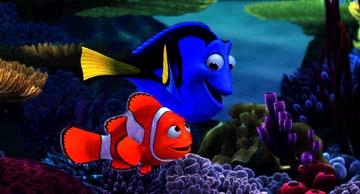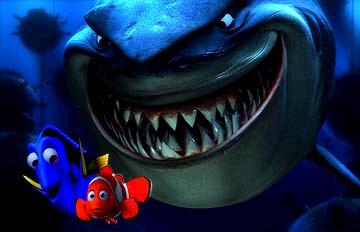

Every time a new Pixar movie comes out, it is safe to assume that the movie will be good. And not only good, but sometimes excellent. With so much junk on movie screens today, a company should be commended when it releases a quality film. For Pixar to release quality movies that are far ahead of everything out there every single time is phenomenal. Together, Disney and Pixar have released five films, all of them critical and financial successes. Their contract together is expiring soon, and it is in Disney's best interests to do what they can to continue this partnership, especially if they keep releasing sub par unnecessary animated sequels. Disney may put up a lot of money, but Pixar is the main party responsible for the creation of these films.
The first thing one notices about Finding Nemo is the look. The detail is breathtaking. Every new CGI film improves upon the last, and Finding Nemo is no exception. The beginning of the film takes place in the Australia's Great Barrier Reef, and the vibrant colors jump right off the screen. Coral, sea anemones, and all sorts of marine flora fill the screen. There is so much to look at that one wishes that director Andrew Stanton (A Bug's Life, A Story) would just stop the movie and let everybody watch the screen for a while. Then, there are the fish. Finding Nemo has what feels like hundreds of species of fish and other marine life, each one rendered with painstaking detail. Most of the animation has a shimmering quality to it that mimics what things may look like underwater, but when the fish come out of the water, one realizes the level of realism. The water looks slick against the scales of the fish, and the images are crystal clear.
Now, a film needs more than great animation (example: Final Fantasy). Stanton (who helped write all of Pixar's films thus far) co-wrote the story with David Reynolds (The Jungle Book 2, Atlantis) and Bob Peterson, in a script brimming with emotion and humor. Clown fish Marlin (voiced by Albert Brooks, The In-Laws, My First Mister) is an overprotective father to his son Nemo (voiced by Alexander Gould, Wheelmen, They). At the beginning of the film, an accident took Marlin's wife and many eggs, leaving him only with Nemo. Now, Marlin is afraid to let Nemo do anything, lest he lose his only son. As a result, Nemo resents his father's overbearing ways, and Marlin is reluctant even to let Nemo go to school. He does, and a dentist captures Nemo and places him in his aquarium. Marlin sets off on a quest to find and rescue Nemo. Coming along with him is Dory (voiced by Ellen Degeneres, Reaching Normal, The Love Letter), a fish with no short-term memory. Meanwhile, Nemo finds himself with Gill (voiced by Willem Dafoe, Auto Focus, Spider-Man), a fish who longs to return to the sea. Gill continually hatches escape plans that never seem to work, and Nemo reignites his passion to return to the sea.
There is a lot going on, and all of it is engaging. Marlin and Dory meet all sorts of characters from reformed sharks, surfer-like turtles, a whale, homicidal seagulls, and a school of fish that does imitations. As they press on towards Sydney, their story becomes like a legend, reaching Nemo and Gill. Back in the dentist's office, Gill and his cohorts spend their time concocting escape plans and criticizing the dentist's technique with Nigel (voiced by Geoffrey Rush, The Banger Sisters, Frida), a friendly pelican. Spending time with Dory forces Marlin to realize that he needs to let go, and spending with Gill teaches Nemo how to be independent. Brooks has honed his uptight persona over the years, and it works to varying effect. Finding Nemo is a film that uses his shtick to the best advantage, with Degeneres serving as a great flighty foil. Every character is a unique individual (er, fish), which is a feat considering how many characters there are. There is plenty of witty humor for children, adults, and both to enjoy. All in all, Finding Nemo is thoroughly entertaining.